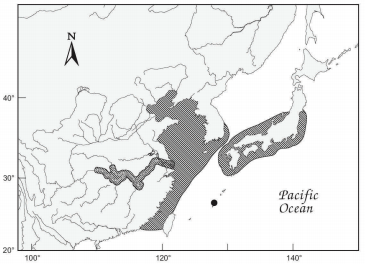INTRODUCTION: NEOPHOCAENA ASIAEORIENTALISThe species: Neophocaena asiaeorientalis
Figure 1. Neophocaena asiaeorientalis. Taxonomy
Kingdom: Animalia -N. a. asiaeorientalis (Pilleri and Gihr, 1972) -N. a. sunameri (Pilleri and Gihr, 1975) Neophocaena asiaeorientalis is a relatively large species of finless porpoise that can grow as much as 2.27m and can weight up to 72kg. The skull dimensions range from 209 to 295mm and has a relatively long and narrow rostrum. Besides, the forehead is long and narrow. N. asiaeorientalis individuals have sixteen to twenty-one teeth in the upper row and fifteen to twenty in the lower one.[2][3] As their common name says, narrow-ridged finless porpoise lacks a true dorsal fin, instead of this, there is a dorsal ridge covered with 1-10 rows of tubercles which form a narrow patch. The other flippers are moderately large.[2][3] Coloration ranges from light cream to dark grey but there are huge individual, geographical and age-related differences.[2][3] Regarding porpoise reproduction, it is important to say that sexual maturity occurs around the 6th year of life. Gestation lasts approximately one year, with only one calf at a time. Newborns alimentate through lactation for over six months.[2][3]
This species lives in temperate coastal waters of the western Pacific Ocean, from the Taiwan Strait northwards to Korea and central Japan, including the middle and lower reaches of the Yangtze River. The known range includes Japanese, Korean, Chinese (including Taiwanese) waters. The subspecie N. a. asiaeorientalis is found exclusively in the Yangtze River, while N. a. sunameri is found in coastal marine and estuarine waters.[3] Its diet is based in small fishes, cephalopods and crustaceans.[1] The calving season appears to be mostly in spring and summer, from March to August, although the populations around the island of Kyushu, Japan, have their calving peak in winter months, from November to December.
Figure 2. Range map of Neophocaena asiaeorientalis.[2] Under the criteria of the IUCN Red List of Threatened Species, this specie was assessed to be Endangered. This may be due to fisheries-related mortality and water contamination. [1] Nowadays, there are conservation strategies to recover normal population of these animals in Japan, China and Indonesia where they hold them in captivity.
For more information about Neophocaena asiaeorientalis, please click the image below: |

